How to Test Rocks with Kids?
One of the best ways to learn about rocks is by making observations and comparing their features. You can do this by testing rocks to see what rocks different types of rocks you have in your collection. Rock testing is perfect for adding to a rock unit study as a hands-on way of exploring the rocks, rock types, and their properties.

Rock Testing and Identification
My son has quite the rock collection. If he is in a place that allows rock collecting, he will be on the lookout for interesting specimens.
He understands how rocks form and knows the difference between sedimentary, igneous, and metamorphic rock as well as how they form together to make a rock cycle.
But how do you tell exactly which type of rock you have collected?
We have included affiliate links to some of the products and resources as an associate we may earn from qualifying purchases.
A good rock guide is essential for helping you. Check one out at the library, buy one, or use an online source. We found geology.com to be a good resource for finding out about our rocks. Check out the rocks link as well as the minerals link. We have included some of our favourite rock guides and information books after the experiment.
Being able to identify rocks allows scientists, engineers, and others to choose the best rock for their needs.
A rock that withstands weathering would be good for using outside.
Rocks are not just used for building, they are used in lots of different products and materials that we use everyday.
A rock guide will have pictures of the rocks as well as descriptions of the rocks’ characteristics and unique features. You may need to do some tests to determine your exact rock.
Buy a rock testing kit that includes common tools for testing and identifying rocks along with a few samples to practice.
Or simply make your own rock testing kit with items you have at home. The most difficult item to source is a streak plate. But it’s just a piece of unglazed porcelain tile that can be found at a home improvement store.
Make Your Own Rock Testing Kit
Here’s what we used for our rock testing kit:
Streak plate (unglazed porcelain tile)
Copper penny
Steel knife/washer or piece of glass (like a microscope slide)
Don’t worry if you don’t have your own rock collection you can purchase a rock set from Amazon to use in this and other rock-based activities for kids.
I created a Rock Observation Sheet for recording the results of the rock testing and observations. You may download the Rock Observation Sheet for your own personal or classroom use only, a second version can be found in the Rock Cycle Activity Printable Pack in our store see below.

Rock Cycle Activity Pack $5.00
Printable Pack with poster, worksheets and rock testing sample sheet to support learning about The Rock Cycle.
Making Rock Observations
Start by looking at the rock and studying its features. On the printable, I ask for a drawing of the rock. Be as detailed as possible. Show the shape of the rock along with any particles that make up the rock. Does the rock have striations, different layers, or any other unique characteristics? Can you immediately tell if it sedimentary or igneous? Or maybe even metamorphic? If not, come back to that question later when you identify the name of your rock. I’ve included a space for recording the rock’s name. You can do that in the beginning if you already know what it is and are just practicing making observations. If you are trying to identify the rock, wait until after your testing to fill in the name.
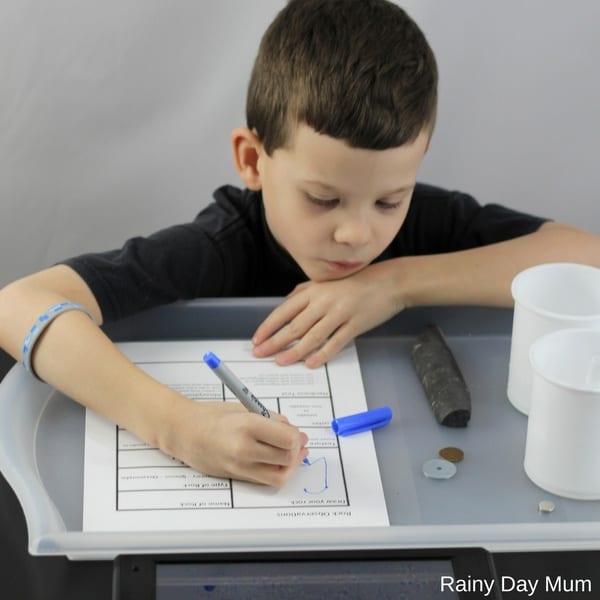
Record the color of the rock. This is often the first way to identify it. You can group your rocks by color and then sort them into different categories based on their other features. While you are looking at the color, you can also think about the rock’s luster. Is it metallic or non-metallic? This also helps narrow down the rock’s type.
Is your rock magnetic? Hold up a magnet to the rock to test this. Does the magnet stick? This means your rock probably has some magnetite in it. (There are some other magnetic minerals but they are pretty weak.) Our rock below is actually a core sample we found discarded by the geology department at a university. (They have a great pile of rocks outside that anyone can take.)
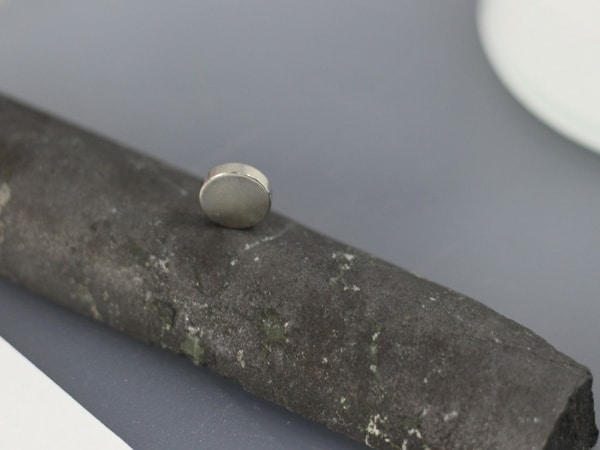
Record the texture of the rock. Is the rock smooth, rough, bumpy, pointy, or rounded? (Watch out for sharp edges.) How would you describe how it feels? Does it feel like sandpaper? That’s a good indication it’s sandstone.
Mineral Testing
Some of the test we’re doing on the rocks are actually designed for minerals. A mineral is a naturally occurring solid substance that is inorganic (made from non-living material). A mineral has one specific chemical composition. A rock can be a combination of different minerals and organic materials. So our tests will help us identify the minerals that are in the rocks. If your rock is made up of more than one mineral, testing in multiple locations will help you identify the different minerals in your rock. Then, you can figure out what type of rock you have.
Perform a streak test. The outside appearance and color of rocks may be different than when the rock is turned into a powder. For example, fluorite can be purple, blue, green, yellow, or clear. When you perform a streak test, fluorite’s streak will always be white. This makes a streak test a very useful tool in helping to decide what mineral you are dealing with. To do the streak test, take your rock and scrape it against a streak plate. Read about the proper way to do a streak test here.

An acid test will tell you if carbonate is present in your rock. The acid reacts with the carbonate to produce bubbles. Limestone and dolostone are made of carbonate rock. Calcite is a common mineral that contains carbonate. Geologists use hydrochloric acid to perform the acid test. Vinegar (acetic acid) will also work. Although the reactions will not be as strong (we won’t see as many bubbles with some rocks). Limestone still produces lots of bubbles with vinegar. Add a few drops of vinegar to your rock and watch for a fizzy reaction. You might want to use a magnifying glass to look for small bubbles.
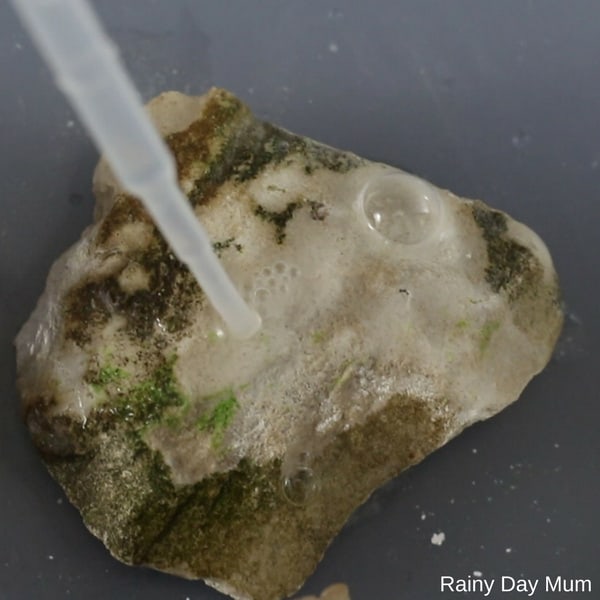
Hardness is the last mineral test we’ll perform on the rocks. Also called a scratch test, Mohs Hardness Test looks at whether or not a mineral can be scratched by another mineral. Mohs Hardness Scale has ten minerals of known hardness. You scratch your rock with each of these minerals to determine where your rock falls on the scale. If your rock can be scratched with a mineral, your rock’s hardness is less than that mineral’s. In the photo below, the rock on the right is harder than the rock on the left because the rock on the right can scratch the rock on the left. However, the rock on the left cannot scratch the rock on the right.

If you don’t have a set of testing minerals, you can use some common objects to determine your rock’s hardness. This is where the copper penny (an old penny made mostly of copper not a new penny made of zinc or steel), the steel pocket knife, steel washer, or glass, and the piece of quartz comes into play. Read more about testing mineral hardness including some tips here. In the picture below, the penny does not scratch the rock. This means the rock is harder than the penny. Try the steel/glass and the quartz next.
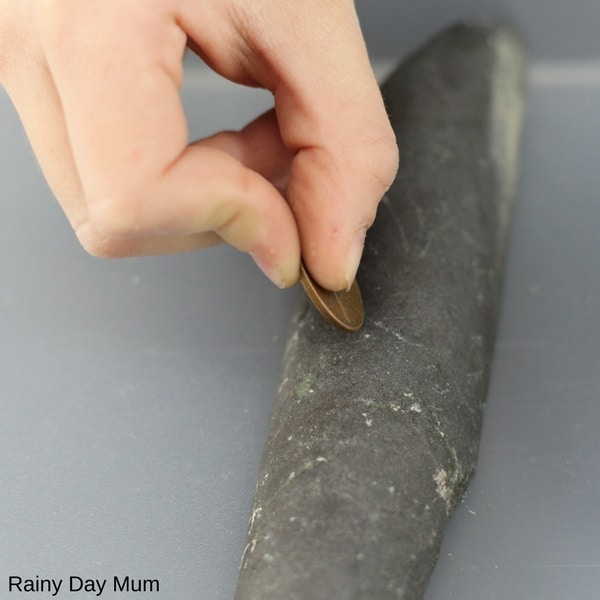
Absorption Test
Our final test is an absorption test. The goal of this test is to see how permeable the rock is. Will water soak into the rock or does it simply run off? How long does it take to soak into it? All of these are clues as to the type of rock.

This also provides an opportunity to ask questions about the rocks. In which rock are you most likely to find water? Which rock would make the best waterproof layer?
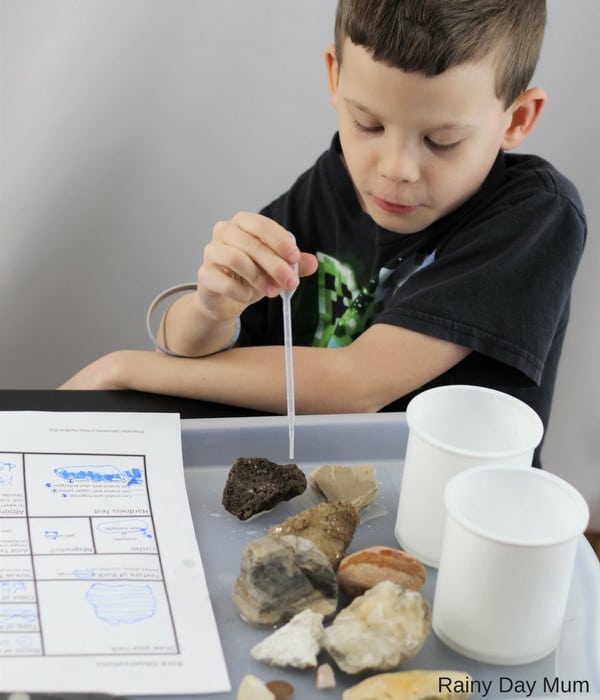
After you have completed the observations and testing of rocks, it’s time to decide which type of rock you have. Check with your rock guide. Which rock best matches the results of your tests?

Books about Rocks for Kids
We love adding additional books to our experiments and activities, check out our rocks, fossils, and earth science book recommendations for kids for a complete collection ideal for classroom or school libraries or if you are looking for the pick of the best, here’s 3 that we recommend and use frequently in our teaching and home learning.
Learn More About Rocks
- You’ll also love this collection of hands-on rock activities for learning about earth science.
- Have younger kids interested in rocks? Read this post to get them started with rock science
- Why not make some models that show how the rocks in plate tectonics help form mountains.
Trisha Stanley
Trisha is an educator with a passion for science literacy and mom to Aiden, Lily, and Elon.
She’s the creator of Inspiration Laboratories, a blog dedicated to encouraging learning through creativity and play.


I was looking forward to the “Get Your FREE Popular Rock Cycle Printables” but when I filled in my name & email, it just took me to another page of identifying rocks. I have 8 children coming over today for a study on rocks. I would love to have the printables to hand out to them.
Excellent information in your threads.
Thank you!
Hi, I’m really sorry that your email didn’t arrive I have just sent you across everything. Cerys